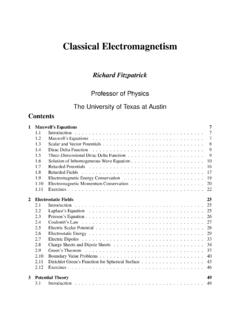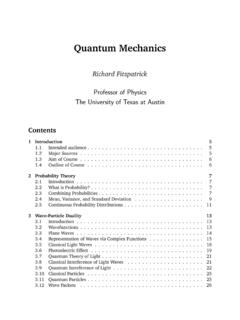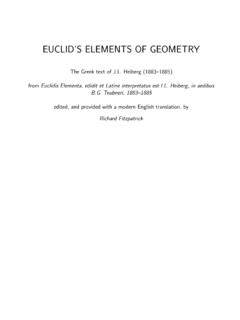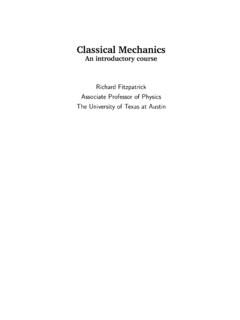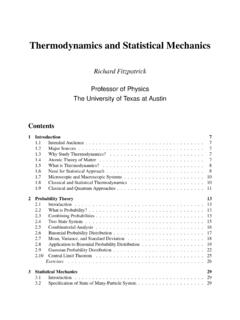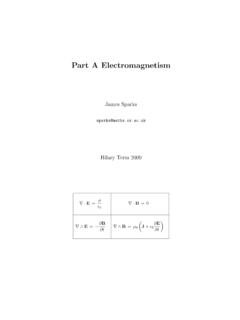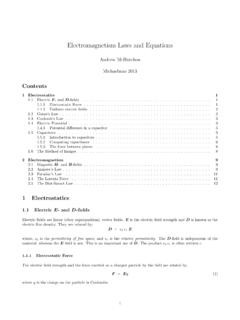Transcription of Classical Electromagnetism - University of Texas at Austin
1 Classical ElectromagnetismRichard FitzpatrickProfessor of PhysicsThe University of Texas at AustinContents1 Maxwell s Introduction .. Maxwell sEquations .. DiracDeltaFunction .. Solution of Inhomogeneous Wave Equation .. RetardedPotentials .. RetardedFields .. ElectromagneticEnergyConservation .. ElectromagneticMomentumConservation .. 222 Electrostatic Introduction .. Laplace s Equation .. Poisson Coulomb sLaw .. ElectricDipoles .. ChargeSheetsandDipoleSheets .. Green sTheorem .. Boundary Value Problems .. DirichletGreen 463 Potential Introduction.
2 492 Classical Laplace s Equation in Spherical Poisson sEquationinSphericalCoordinates .. Laplace s Equation in Cylindrical Coordinates .. Poisson sEquationinCylindricalCoordinates .. 694 Electrostatics in Dielectric Polarization .. Boundary Conditions Boundary Value Problems with Dielectrics .. Clausius-MossottiRelation .. DielectricLiquidsinElectrostaticFields .. 895 Magnetostatic Introduction .. Continuous Current Distribution .. LocalizedCurrentDistribution .. Magnetostatics in Magnetic Magnetization .. Magnetic Susceptibility and Permeability.
3 Boundary Conditions PermanentFerromagnets .. UniformlyMagnetizedSphere .. SoftIronSphereinUniformMagneticField .. MagneticShielding .. Wave Propagation in Uniform Dielectric Introduction .. Wave Propagation in Conducting Media .. WavePropagationinMagnetizedPlasmas .. BrillouinPrecursor .. SignalArrival .. Wave Propagation in Inhomogeneous Dielectric Introduction .. FresnelRelations .. Reflection by Conducting Surfaces .. Ionospheric Radio Wave Propagation .. WKBA pproximation .. Reflection Coefficient .. Ionospheric Pulse Measurement of Ionospheric Electron Density Profile.
4 Ionospheric Ray Tracing .. WKBS olutionasAsymptoticSeries .. WKB Reflection Radiation and Introduction .. Antenna Directivity and AntennaArrays .. RayleighScattering .. Resonant Cavities and Introduction .. Boundary Conditions .. Cavities with Rectangular Boundaries .. Quality Factor of a Resonant Cavity .. Axially Symmetric Cavities .. Cylindrical Cavities .. Waveguides .. Multipole Introduction .. Angular Momentum Solution of Inhomogeneous Helmholtz Equation .. Relativity and Introduction .. RelativityPrinciple .. Transformation of Velocities .. PhysicalSignificanceofTensors.
5 Space-Time .. ProperTime .. 4-Velocity and 4-Acceleration .. Tensors and Pseudo-Tensors .. Accelerated Charges .. Angular Distribution of Radiation .. ELECTROMAGNETISMM axwell s Equations71 Maxwell s IntroductionThis chapter gives a general overview of Maxwell s Maxwell s EquationsAll Classical ( , non-quantum) electromagnetic phenomena are governed byMaxwell s equa-tions, which take the form E= 0,( ) B=0,( ) E= B t,( ) B= 0j+ 0 0 E t.( )Here,E(r,t),B(r,t), (r,t), andj(r,t)representtheelectric field-strength,themagnetic field-strength,theelectric charge density,andtheelectric current density, respectively. Moreover, 0= 10 12C2N 1m 2( )is theelectric permittivity of free space, whereas 0=4 10 7NA 2( )is themagnetic permeability of free space.
6 As is well known, Equation ( ) is equivalent toCoulomb s law(for the electric fields generated by pointcharges), Equation ( ) is equivalent tothe statement that magnetic monopoles do not exist (which implies that magnetic field-lines cannever begin or end), Equation ( ) is equivalent toFaraday s law of electromagnetic induction,and Equation ( ) is equivalent to theBiot-Savart law(for the magnetic fields generated by linecurrents) augmented by the induction of magnetic fields by changing electric s equations are linear in nature. In other words, if andj j,where is anarbitrary (spatial and temporal) constant, then it is clear from Equations ( ) ( ) thatE EandB B.
7 The linearity of Maxwell s equations accounts for the well-known fact that theelectric fields generated by point charges, as well as the magnetic fields generated by line currents,are the divergence of Equation ( ), and combining the resulting expression with Equa-tion ( ), we obtain t+ j=0.( )8 Classical ELECTROMAGNETISMIn integral form, making use of the divergence theorem, this equation becomesddt V dV+ Sj dS=0,( )whereVis a fixed volume bounded by a surfaceS. The volume integral represents the net electriccharge contained within the volume, whereas the surface integral represents the outward flux ofcharge across the bounding surface. The previous equation, which states that the net rate of changeof the charge contained within the volumeVis equal to minus the net flux of charge across thebounding surfaceS, is clearly a statement of theconservation of electric charge.
8 Thus, Equa-tion ( ) is the differential form of this conservation is well known, a point electric chargeqmoving with velocityvin the presence of an electricfieldEand a magnetic fieldBexperiences a forceF=q(E+v B).( )Likewise, a distributed charge distribution of charge density and current densityjexperiences aforce densityf= E+j B.( ) Scalar and Vector PotentialsWe can automatically satisfy Equation ( ) by writingB= A,( )whereA(r,t)istermedthevector potential. Furthermore, we can automatically satisfy Equa-tion ( ) by writingE= A t,( )where (r,t)istermedthescalar previous prescription for expressing electric and magnetic fields in terms of the scalar andvector potentials does not uniquely define the potentials.
9 Indeed, it can be seen that ifA A and + / t,where (r,t) is an arbitrary scalar field, then the associated electric andmagnetic fields are unaffected. The root of the problem lies in the fact that Equation ( ) specifiesthe curl of the vector potential, but leaves the divergence of this vector field completely can make our prescription unique by adopting a convention that specifies the divergence of thevector potential such a convention is usually called agauge condition. It turns out that Maxwell sequations are Lorentz invariant. (See Chapter 12.) In other words, they take the same form in allinertial frames. Thus, it makes sense to adopt a gauge condition that is also Lorentz invariant.
10 Thisleads us to the so-calledLorenz gauge condition(see Section ), 0 0 t+ A=0.( )Maxwell s Equations9 Equations ( ) ( ) can be combined with Equations ( ) and ( ) to give1c2 2 t2 2 = 0,( )1c2 2A t2 2A= 0j,( )wherec=1 0 0= 108ms 1( )is thevelocity of light in vacuum. Thus, Maxwell s equations essentially boil down to Equa-tions ( ) and ( ). Dirac Delta FunctionTheDirac delta function, (t t ), has the property (t t )=0fort t .( )In addition, however, the function is singular att=t in such a manner that (t t )dt =1.( )It follows that f(t) (t t )dt =f(t),( )wheref(t) is an arbitrary function that is well behaved att=t . It is also easy to see that (t t)= (t t ).
